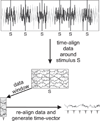Delay differential analysis of electroencephalographic data
- PMID: 25149701
- PMCID: PMC4372301
- DOI: 10.1162/NECO_a_00656
Delay differential analysis of electroencephalographic data
Abstract
We propose a time-domain approach to detect frequencies, frequency couplings, and phases using nonlinear correlation functions. For frequency analysis, this approach is a multivariate extension of discrete Fourier transform, and for higher-order spectra, it is a linear and multivariate alternative to multidimensional fast Fourier transform of multidimensional correlations. This method can be applied to short and sparse time series and can be extended to cross-trial and cross-channel spectra (CTS) for electroencephalography data where multiple short data segments from multiple trials of the same experiment are available. There are two versions of CTS. The first one assumes some phase coherency across the trials, while the second one is independent of phase coherency. We demonstrate that the phase-dependent version is more consistent with event-related spectral perturbation analysis and traditional Morlet wavelet analysis. We show that CTS can be applied to short data windows and yields higher temporal resolution than traditional Morlet wavelet analysis. Furthermore, the CTS can be used to reconstruct the event-related potential using all linear components of the CTS.
Figures






References
-
- Chan Y, Langford R. Spectral estimation via the high-order Yule-Walker equations. IEEE Transactions on Acoustics, Speech and Signal Processing. 1982;30(5):689–698.
-
- Delorme A, Makeig S. EEGLAB: An open source toolbox for analysis of single-trial EEG dynamics including independent component analysis. J. Neurosci. Methods. 2004;134(1):9–21. - PubMed
-
- Doesburg S. Synchronization between sources: Emerging methods for understanding large-scale functional networks in the human brain. In: Velazquez J, Wennberg R, editors. Coordinated activity in the brain: Measurements and relevance to brain function and behavior. Vol. 2. New York: Springer; 2009. pp. 25–42.
-
- Farmer S. Neural rhythms in Parkinson’s disease. Brain. 2002;125(6):1175–1176. - PubMed
-
- Goertzel G. An algorithm for the evaluation of finite trigonometric series. American Mathematical Monthly. 1958;65(1):34–35.

